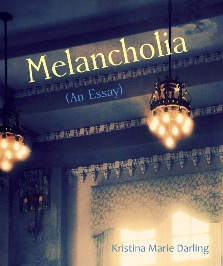 Melancholia (An Essay)
Melancholia (An Essay)
by Kristina Marie Darling
Ravenna Press, 2012
72 pages / $10 Buy from Ravenna Press
Parenthetically titled “An Essay,” Kristina Marie Darling’s Melancholia is a collection of prose poems, independent lines, notes, and fragments. Prose poetry and essays are not imperfect bedfellows. Samuel Johnson defined the essay form as “A loose sally of the mind: an irregular indigested piece; not a regular and orderly composition.” His definition sounds appropriate to the form’s modern originator, 16th century French writer Michel de Montaigne, whose works unfold as scattered meditations on words and concepts. Yet Johnson’s definition is also curiously apt as a description of contemporary prose poetry. Often lacking a central narrative, prose poems typically contain development of breadth rather than depth. Darling solves that problem by using the prose poem form to link imagistic snapshots that accumulate the work’s emotional content.
Yet Melancholia is difficult to classify. Its structural form is prose poetry, its conceptual mode is almost filmic, and its narrative mode owes much to the essay’s tendency to classify and define. Melancholia posits that a poet-narrator is a good choice to “select and omit”: Darling’s prose poems are more concerned with absence than presence, as white space outweighs text within the book. Such ratio is not shocking in a volume of poetry, but the prose poetic form reestablishes the physical page in poetry. When a poet reaches for the margins in her sentences, her later abbreviations become more obvious. Darling has a nice sense of the physical page, and Ravenna Press’s pocket series, at roughly 6 by 5 inches, is the right size for a typographically spare collection.
Darling’s complicated form mirrors her complicated content. Melancholia documents a fragmented relationship in a previous, possibly Victorian, era. Time is ambiguous in the collection: although the overarching narrative occurs in an epoch of cufflinks and corsages, the work references a “little-known French film, in which the heroine makes her living by keeping nightingales,” and another, equally obscure film, where “a woman refers to her beloved as a ‘strange machine.’” This confusion about time arises from the poet’s role as essayist. Darling’s core narrative is centered on a feuding, and later separated, couple, but she overlays that narrative with fragments of fact. Her reason for bending form is tied to her title: melancholy lacks the sharp edges of anger and sadness. It is a paradoxical feeling of heft and weightlessness, so a poet would be smart to mix poetry and fact as she struggles to understand pain.
The couple’s separation is hinted in the book’s first words: “Dearest‑‑ / you were like bits of broken grass / when the jewelry box shattered.” The box is found broken within their elaborate home. Darling constructs this dark, grand location in images that feel like glanced photographs: silver buttons, staircases ascended and descended, and muffled music. These images become symbols in the Yeatsian tradition. Yeats conceived of symbols within a loosely defined dreamworld that held collective experiences: “all sounds, all colours, all forms, either because of their preordained energies or because of long association, evoke indefinable and yet precise emotions.” By emotions Yeats meant “disembodied powers”: phantasmagoric movements, with the poet as magician and conjurer. Everything in Melancholia is blurred and burned, twisted into new form; or, as the woman writes to her lover, “a dream within the dream.”
Darling’s unifying symbol is that gifted jewelry box, which previously contained “a miniature dancer” whose “steps were mechanical, but in another sense, automatic.” That box becomes broken, like the “latch on her door” in the midst of an argument. The lovers soon part, but the woman is beautifully scarred: “The enamel roses on her locket had long since tarnished, but she slept with the charm fastened at the back of her magnificently white neck. Its fractures left faint marks on her delicate skin.” Darling plays with the proximity of faded to fated as jewelry becomes the perfect metonym for time within relationships. Even the woman’s memory of her lover’s coat button, “garnished with an elaborate coat-of-arms,” has changed: its “painstakingly engraved lion seemed docile, almost delicate, once the light began to fade.”
The text evolves along with the relationship. Compact vignettes are replaced with a glossary and footnotes, appropriate structures for a mind interested in definition and categorization amidst grief. The footnotes appear at the bottom of blank pages, as if the reader is receiving explanations for an unheard conversation. As if to give grief a more tangible form, machines replace the organic nature of love: the man has a leather notebook full of “the most elaborate diagrams” of nightingales, a bird whose “feathers were said to house the most intricate machine.” The man later becomes the machine, as his lover “wanted to see the cold metal gears turning in his cast-iron heart.” Even the landscape “seemed almost mechanical.” The footnotes end abruptly, and Melancholia, true to its name, closes this particular ruined world.
***
Tags: Kristina Marie Darling, Melancholia, nick ripatrazone
